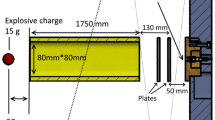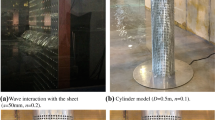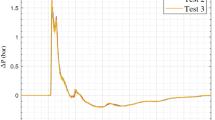Abstract
A simplified analysis can be employed to predict the pressure buildup behind a porous barrier fairly accurately without resorting to numerical modeling. A macroscopic approach is used in which the pressure buildup behind the porous barrier is analyzed in relation to the load inflicted on its front face thus allowing finding the effects of the different parameters of the porous barrier. This method was successfully employed to study the impingement of shock waves and blast waves on stiff silicon carbide foams and more recently on buildings that had enough internal divisions as to be considered as a low porosity medium. In this study, the methodology is employed to study a porous barrier comprised from an array of perforated plates with various porosities to determine the parameters affecting the pressure buildup behind it. Perforated plates were chosen since the geometry of the barriers assembled from the plates is simple enough so it can be exactly defined, and still the shock structure and the developing fields are so complicated that only few studies attempted to deal with similar scenarios in the past. In fact, previous studies were limited to one or two perforated plates. In the experiments presented, 3 mm plates were placed 8 mm apart inside a 32 mm by 32 mm shock tube. The last plate was mounted 10 mm from the end wall. The plates were drilled to accommodate various blockage ratios (defined as blocked to open area ratio) ranging from 50% to 80%. It was found that the volume of air confined inside the porous medium undergoes an adiabatic process, and thus the pressure buildup time at the end wall depends on the volume to the power of the heat capacities ratio.
Access provided by Autonomous University of Puebla. Download conference paper PDF
Similar content being viewed by others
1 Introduction
Porous barriers have the potential of mitigating the loads that develop behind them following the impingement of shock or blast waves. Due to this potential, the propagation of shock waves through porous barriers and the developing loads behind them has been the focus of many studies in recent years. Various porous barriers have been proposed and studied before. Among these are silicon carbide filters [1,2,3,4], sets of columns with various geometries [5, 6], sets of buffers [7, 8], packed granular media [9, 10], perforated plates [11,12,13,14,15,16], and more. Most of these studies employed an experimental investigation into the effects of the various porous barrier properties on the propagation of a shock wave through them, its attenuation, and the developing flow field behind them. A specific case was considered in some studies where the porous medium was placed in a tunnel with a standoff distance to the end wall thus forming a confined volume of air behind it. This scenario is complicated since the conditions behind the porous medium do not remain constant. The transmitted shock wave propagates into the confined volume, impinges on the end wall, reflects upstream toward the porous barrier, and reverberates back and forth inside the confined volume. Its strength declines with each encounter with the back wall until it subsides. In parallel to this feature, the pressure gradients that form on the two faces of the porous medium drive a fast mass flow into the confined volume causing its pressure to increase. The flow into the confined volume continues until pressure equalization occurs and the pressure in the confined volume reaches the pressure on the front face of the porous medium. The mass flow into the confined volume is high at the beginning, but it subsides as the pressure subsides; the relation between the two is inherently nonlinear. The unsteady mass flow through the porous medium increases the difficulty of predicting the pressure buildup and, in turn, also inhibits the ability to study the effects of various parameters such as the volume, the length of the porous barrier, and the properties of the porous barrier itself. This paper presents a part of an ongoing study into the parameters that govern the pressure buildup behind the porous barrier. Perforated plates were suggested before as means of mitigating shock and blast waves in tunnels and were proven effective by experiments. However, while being one of the simplest porous media, the shock interaction with the perforated plates, the transmitted shock between the plates, and the resulting flow through them are so complex. To the best of our knowledge, no study had studied the pressure buildup behind a set of more than two perforated plates. A macroscopic approach is used to examine this scenario in which the pressure buildup behind the porous barrier is analyzed in relation to the load inflicted on its front face thus allowing finding the effects of the different parameters of the porous barrier. This method was successfully employed to study the impingement of shock waves and blast waves on stiff silicon carbide foams [2, 3] and more recently on buildings that had enough internal divisions to be considered as low porosity media [17]. Since the methodology that is described above does not require the solution of the microscopic interaction between the fluid and the plates, a set of many perforated plates with various properties can be studied.
2 Experimental Setup
The experimental investigations were performed in a shock tube located at the Protective Technologies R&D Center of the Ben-Gurion University of the Negev (BGU-PTR&DC). A horizontal, 6-m long shock tube with an internal square cross section of 32 mm by 32 mm was used. A schematic description of the experimental apparatus is depicted in Fig. 1.
The basic configuration of pressure measurements consisted of three Endevco 8530b-500 pressure transducers (PT): two were located along the shock tube spaced by 600 mm, and a third pressure transducer was mounted on the end wall. The pressure transducers along the shock tube were used to monitor the shock speed. The shock wave velocity that was generated in the shock tube was very repeatable and varied by no more than 2% between experiments performed with the same conditions. A number of perforated plates (examples are shown in Fig. 2) were mounted in the test section in grooves that formed a tight fit and were held in place by pins running through the outer frame of the test section. The grooves that were not used in the experiments were filled by spacers that completed the shock tube inner surface so not to disturb the flow. The entire shock tube operation was computer controlled, and an in-house designed trigger box was used to trigger a Lecroy WaveJet 314 oscilloscope that recorded the pressure profiles. The driver section was filled with compressed air to a predetermined pressure and was separated by a KB-40 fast-opening valve manufactured by ISTA Inc. According to the manufacturer specifications, the fast-opening valve has an opening time of 1–2 ms. The test section entrance was more than 100 diameters from the fast-opening valve, a distance that enabled for any irregularities caused by the valve opening to subside. The shock wave was also monitored in order to make sure that it is sharp and plane in the test section entrance and is not affected by the opening of the valve. In order to analyze the effects of porosity and perforation size on the pressure buildup behind the plates array, several models were manufactured from Perspex by CNC (Fig. 2). In addition to the area of the plate that faces the flow, each plate was extended in two directions to allow mounting them in grooves machined in the shock tube walls. The models were all manufactured out of a 3 mm plate. Porosities were chosen ranging from 11% open area to 44.2% open area. All of the perforations used in the experiments were round and were evenly distributed inside the 32 mm by 32 mm cross section of the shock tube.
3 Results
Figure 3 depicts the end-wall pressure recordings from a set of experiments performed with three porosities. As can be expected, the pressure buildup duration highly depends on both the porosity of the plate and on the number of plates. It is shown in Fig. 3 that as the number of plates increases, in addition to prolonging the pressure buildup duration, the shock wave that reaches the end wall gets significantly attenuated. For example, in experiments performed with a porosity of 23.4% and more than five perforated plates, a sharp shock front was not recorded at the end wall.
End-wall pressure from experiments performed with increasing number of perforated plates performed with (a) porosity of 23.4%, 7 x 7 hole matrix, and perforation diameter of 2.5 mm; (b) porosity of 33.8%, 7 × 7 hole matrix, and perforation diameter of 3 mm; (c) porosity of 442%, 6 × 6 hole matrix, and perforation diameter of 4 mm
As seen in previous studies of shock propagation through porous barriers that have a confined volume behind them, Fig. 3 shows that the pressure profiles have a behavior that follows the exponential decaying pressure buildup presented in Eq. (1):
where each experiment has a different constant A and P 5 is the same reflected pressure that would have been developed at the end wall without a porous barrier. A previous study [2, 3] showed that the pressure buildup behind a stiff porous medium could be essentially studied as a lumped mechanical system in which the porous medium and the confined volume of air in it could be modeled as a low-pass filter. It was shown that essentially, the porous medium and the confined air mitigated the propagation of fast-changing pressure pulses and the pressure buildup on the end wall. This model incorporated an experimental parameter, α, which was porous medium specific. This experimental parameter lumped the properties of the porous medium that affected the pressure buildup. Since SiC filters whose geometry was random and difficult to characterize were used, the previous study did not provide the dependence of α on the specific properties of the porous medium. A fit of Eq. (1) to the experimental results shown in Fig. 3a using a least square method is shown in Fig. 4a. The results show that Eq. (1) gives a good representation of the pressure profiles recorded on the end wall.
The volume of gas that is confined within the porous plate array can be calculated as
where N p is the number of plates, A ST is the surface area of the shock tube, S i is the distance between the plate i and plate i − 1, i = 0 is the end wall, ϕ is the porosity calculated from ϕ = A open/A ST, and s is the thickness of i-th plate.
The parameter A in Eq. (1) was obtained by a linear fitting to the log-log plot of A vs. the volume of gas that is confined within the porous plate array (Eq. 2). The linear fitting is shown in Fig. 4b. Figure 4 shows that A depends on the volume of the gas confined within the perforated plate array by the power of −1.393 (the slope of the linear regression line).
An explanation of the slope found in Fig. 4b is based on the analysis presented by Ram and Sadot [2]. We assume that after the initial reflection of the shock wave, the gas that flows between the plates undergoes an adiabatic compression process that follows the relation
where γ is the heat capacity ratio (1.4 for air) and V gas is the volume of the air contained by the porous medium which is calculated by Eq. (2).
Equation (3) shows that
These results explain the linear regression line slope shown in Fig. 4b and in fact shows that the perforated plates array can be analyzed as a porous medium.
4 Conclusions
The problem of shock wave propagation through a large array of perforated plates is difficult to model since there are multiple scales involved in the developing flow field (perforations diameter, shock tube’s cross section area, etc.). Furthermore, the fast flow that propagates through the perforated plates array undergoes a large number of contractions and expansions generating a complex flow field that requires a viscous solution that also correctly models the flow interaction with the multiple shock reflections inside the porous medium. This study adopts a macroscopic experimental approach to find the effects of the different parameters of the perforated plates array. This approach does not concern with the fine features of the flow field and internal shock reflections inside the porous barrier but rather focuses on the pressure buildup profile that develops behind the plates array. This method allows studying the influence of the different parameters with a reduced complexity. The initial results presented in this paper show that the pressure buildup time behind the porous barrier is highly effected both by the porosity of the plates and by the number of plates. While the fact that decreasing the plates’ porosity increases the resistance to the flow and subsequently increases the pressure buildup time is not surprising, the effects of increasing the barrier length by adding more plates are not so intuitive. It was shown that increasing the number of plates effectively increases the volume confined in the porous medium. It was found that the pressure buildup time depends on the confined volume to the power of the heat capacity ratio γ, i.e., 1.4 in the case of air. This dependency was shown to stem from the fact that the flow into the confined volume following the initial shock impingement is adiabatic.
References
A. Levy, G. Ben-Dor, B.W. Skews, S. Sorek, Head-on collision of normal shock waves with rigid porous materials. Exp. Fluids 15, 183–190 (1993). https://doi.org/10.1007/BF00189885
O. Ram, O. Sadot, A simple constitutive model for predicting the pressure histories developed behind rigid porous media impinged by shock waves. J. Fluid Mech. 718, 507–523 (2013). https://doi.org/10.1017/jfm.2012.627
O. Ram, O. Sadot, Analysis of the pressure buildup behind rigid porous media impinged by shock waves in time and frequency domains. J. Fluid Mech. 779, 842–858 (2015). https://doi.org/10.1017/jfm.2015.463
A. Levy, S. Sorek, G. Ben-Dor, J. Bear, Evolution of the balance equations in saturated thermoelastic porous media following abrupt simultaneous changes in pressure and temperature. Transp. Porous Media 21, 241–268 (1995). https://doi.org/10.1007/BF00617408
A. Chaudhuri, A. Hadjadj, O. Sadot, G. Ben-Dor, Numerical study of shock-wave mitigation through matrices of solid obstacles. Shock Waves 23, 91–101 (2012). https://doi.org/10.1007/s00193-012-0362-2
H. Naiman, D.D. Knight, The effect of porosity on shock interaction with a rigid, porous barrier. Shock Waves 16, 321–337 (2007). https://doi.org/10.1007/s00193-007-0077-y
S. Berger, O. Sadot, G. Ben-Dor, Experimental investigation on the shock-wave load attenuation by geometrical means. Shock Waves 20, 29–40 (2010). https://doi.org/10.1007/s00193-009-0237-3
S. Sha, Z. Chen, X. Jiang, J. Han, Numerical investigations on blast wave attenuation by obstacles. Procedia Eng 45, 453–457 (2012). https://doi.org/10.1016/j.proeng.2012.08.185
G. Ben-Dor, A. Britan, T. Elperin, O. Igra, J.P. Jiang, Experimental investigation of the interaction between weak shock waves and granular layers. Exp. Fluids 22, 432–443 (1997). https://doi.org/10.1007/s003480050069
A. Britan, G. Ben-Dor, Shock tube study of the dynamical behavior of granular materials. Int. J. Multiphase Flow 32, 623–642 (2006). https://doi.org/10.1016/j.ijmultiphaseflow.2006.01.007
B.W. Skews, K. Takayama, Flow through a perforated surface due to shock-wave impact. J. Fluid Mech. 314, 27 (1996). https://doi.org/10.1017/S0022112096000225
A. Britan, A.V. Karpov, E.I. Vasilev, O. Igra, G. Ben-Dor, E. Shapiro, Experimental and numerical study of shock wave interaction with perforated plates. J. Fluids Eng. 126, 399 (2004). https://doi.org/10.1115/1.1758264
H. Onodera, Shape of a shock wave front diffracting on a perforated wall. Exp. Fluids 24, 238–245 (1998). https://doi.org/10.1007/s003480050170
K. Kontis, R. An, H. Zare-Behtash, D. Kounadis, Head-on collision of shock wave induced vortices with solid and perforated walls. Phys. Fluids 20 (2008). https://doi.org/10.1063/1.2837172
S. Seeraj, B.W. Skews, Dual-element directional shock wave attenuators. Exp. Thermal Fluid Sci. 33, 503–516 (2009). https://doi.org/10.1016/j.expthermflusci.2008.11.002
B. Skews, Shock wave interaction with porous plates. Exp. Fluids 39, 875–884 (2005). https://doi.org/10.1007/s00348-005-0023-7
O. Ram, E. Nof, O. Sadot, Dependence of the blast load penetrating into a structure on initial conditions and internal geometry. Exp. Thermal Fluid Sci. 78, 65–74 (2016). https://doi.org/10.1016/j.expthermflusci.2016.05.012
Author information
Authors and Affiliations
Corresponding author
Editor information
Editors and Affiliations
Rights and permissions
Copyright information
© 2019 Springer Nature Switzerland AG
About this paper
Cite this paper
Ram, O., Ben-Dor, G., Sadot, O. (2019). Shock Wave Propagation Through a Series of Perforated Plates. In: Sasoh, A., Aoki, T., Katayama, M. (eds) 31st International Symposium on Shock Waves 2. ISSW 2017. Springer, Cham. https://doi.org/10.1007/978-3-319-91017-8_90
Download citation
DOI: https://doi.org/10.1007/978-3-319-91017-8_90
Published:
Publisher Name: Springer, Cham
Print ISBN: 978-3-319-91016-1
Online ISBN: 978-3-319-91017-8
eBook Packages: EngineeringEngineering (R0)








